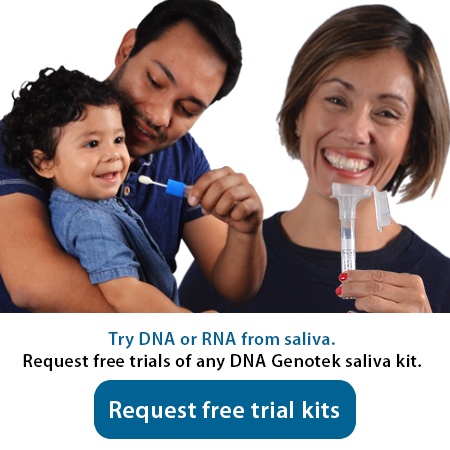2012-06-05
The first step in all genetic research and testing is obtaining a reliable DNA sample. The time and effort required to access donors and the high costs of downstream analysis make each DNA sample a very precious commodity. Confidence in sample quality and performance is of utmost importance. So, what measures confidence in a DNA sample? High quantity and high quality DNA. DNA quantity and quality are expected to be high in a blood sample however this method often presents challenges. The invasive nature of a blood draw reduces donor compliance, increases the complexity and cost required for collection, shipping and storage of samples.
Oral based sample collection methods can be the answer! That is, as long as they perform reliably.
Many studies have proven that the Oragene/saliva collection kit results in higher DNA yield and quality than other oral collection methods. DNA Genotek offers a line of saliva-based collection products with a range of yield and stability capabilities. Average yields range from 110 µg/2 ml saliva in Oragene kits to 3.9 µg/sponge in the new ORACollect•DNA[1] kit. In comparison, buccal swab methods may yield as little as 0.2 μg/swab of DNA[2].
One study, titled New Saliva DNA Collection Method Compared to Buccal Cell Collection Techniques for Epidemiological Studies, states “Whole-saliva collection provided an average DNA yield that was significantly greater than all other [oral] methods... Median yield [of Oragene]… was approximately three times the median yield of the oral rinse, and more than 12 times the median yields for the buccal swab and brush methods.”[3]
While most scientists prefer large amounts of DNA, technological advances in downstream platforms now enable testing on even small amounts of DNA with the caveat that the DNA is of sufficient quality. While there may be enough DNA in most oral samples, the question is then, is the DNA of high enough quality to provide reliable results?
Bacteria can be a valid concern when collecting from an oral source. Although Oragene/saliva samples contain a small amount of bacterial DNA in addition to human genomic DNA, this bacterial DNA has minimal practical significance as the vast majority of DNA in the sample is of human origin (on average 88.2%)[4]. Multiple studies confirm DNA from saliva collected with Oragene results in high quality DNA, performing equivalently to blood for applications such as next-generation sequencing, PCR, SNP, genotyping and microarrays. In comparison, DNA collected from buccal swab and brush methods have an average human genomic component of only 11.5%[4], resulting in low quality DNA unsuitable for and unreliable in many downstream tests.
One study, titled Collection of Blood, Saliva, and Buccal Cell Samples in a Pilot Study on the Danish Nurse Cohort: Comparison of the Response Rate and Quality of Genomic DNA states:
“Analysis of purified genomic DNA by NanoDrop and agarose gel electrophoresis revealed that blood and saliva samples resulted in DNA with the best quality, whereas the DNA quality from buccal cells was low… only the quality of genomic DNA from saliva samples was comparable with blood samples as accessed by purity, genotyping, and PCR amplification.”[5]
Another from Rogers et al, titled New Saliva DNA Collection Method Compared to Buccal Cell Collection Techniques for Epidemiological Studies, highlights:
“The mean [PCR] amplification success rate was 99% for DNA isolated from whole saliva … rates for cytobrush (84%) and swab DNA (75%)…”[3]
In addition, Oragene self-collection kits are proven to provide a complete mailing solution, long term stability at ambient temperature, and an accessory sponge for collecting saliva from those who cannot spit.
Rogers et al continues: “…The Oragene saliva collection kit is reported to be stable at room temperature for a period of up to 12 months [now up to 5 years] from time of collection…this would be a key advantage in the shipping and storage of DNA samples … with off-site collection.”
Another study by Chokklingam et al reports: “the cytobrush collection was replaced with Oragene saliva collection kits …due to the enhanced quality and quantity of DNA … as well as their ease of use and ability to stabilize DNA at room temperature. The Oragene sponge accessory kits were used to collect saliva from individuals who could not expectorate.”[6]
In conclusion, for any type of genetic analysis (e.g., clinical genetic testing, paternity testing, pharmacogenomic testing, population studies), non-invasive methods and self-collection techniques offer many benefits. When compared to buccal swab DNA collection, Oragene/saliva samples are proven to be a reliable and convenient source of high-quantity and quality DNA proven to perform as well as blood on downstream test platforms.
Oragene•Dx has been cleared for in vitro diagnostic use in the U.S.A. FDA cleared for in vitro diagnostic use with the eSensor® Warfarin Sensitivity Saliva Test. Oragene•DISCOVER is for research use only, not for use in diagnostic procedures. Oragene•DNA and ORAcollect•DNA are for in vitro diagnostic use. Oragene•DNA and ORAcollect•DNA are not available for sale in the United States.References:
[1] ORAcollect.DNA is not available for sale in the United States.
[2] Panford-Walsh R., Doukhanine E. and Bouevitch A. (2011). Comparison of DNA from samples collected using ORAcollect•DNA vs. buccal swabs. DNA Genotek. PD-WP-00021.
[3] Rogers N.L. et al. New Saliva DNA Collection Method Compared to Buccal Cell Collection Techniques for Epidemiological Studies. Am J Hum Biol. 19:319–326 (2007).
[4] C. James, R.M. Iwasiow, H.C. Birnboim (2011).Human genomic DNA content of saliva samples collected with the Oragene self-collection kit. DNA Genotek. PD-WP-011.
[5] Hanson T.v.O. et al. Collection of Blood, Saliva, and Buccal Cell Samples in a Pilot Study on the Danish Nurse Cohort: Comparison of the Response Rate and Quality of Genomic DNA. Cancer Epidemiol Biomarkers Prev. 16(10): 2072-2076 (2007).
[6] Chokklingam A.P. et al. Genetic Susceptibility to Childhood Leukaemia. Radiat Prot Dosim. 132(2): 119–129 (2005).


